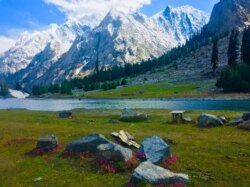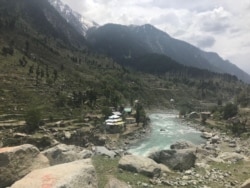The coronavirus pandemic has devastated tourism in an alpine valley of northwestern Pakistan that had barely recovered from years of Taliban control and the military operations that displaced the region’s entire population a decade ago.
Hoteliers, restaurateurs, and others who work in tourism in Swat Valley, a district in Khyber Pakhtunkhwa Province, say the coronavirus pandemic has effectively killed incomes as tourists avoid visiting the region famous for its natural beauty and unique cultural heritage.
“Our hotels have been shut for more than two months. We really don’t know when we will be able to reopen,” Zahid Khan, the president of the hotel association in Swat, told Radio Mashaal.
Khan says tourism in Swat had grown in recent years after reclaiming its former glory, creating jobs and new revenue streams. He estimates the region’s tourism industry lost nearly $45 million in business between 2007 and 2010. After their emergence in Swat in 2005, the Taliban had imposed harsh rule by 2007. A military operation to oust them from the region in 2009 also forced its estimated 3 million residents to flee.
“The tourism industry now employs up to 15,000 people while the number of hotels and other businesses has increased,” he said. “If the crisis continues, we are likely to increase our losses.”
Every year, hundreds of thousands of Pakistanis and foreigners flocked to Swat to enjoy its cool weather, whitewater rivers, glacial lakes, pine forests, Buddhist heritage, and the towering Hindu Kush Mountains.
Shireenzada Badr, the head of the tour operator association in Swat, says they had witnessed a remarkable growth in tourism before the coronavirus pandemic.
“We were booming and raking in increasing profits. We had closed the previous year on a high note,” he told Radio Mashaal. “We were getting visitors year-round, even outside of the [summer] season.”
Kamran Afridi, director general of Khyber Pakhtunkhwa’s culture and tourism office, says the region has already suffered more than $1 million in losses since growing coronavirus cases pushed the authorities to impose a lockdown in March.
“Losses will not be immediately recouped. Even a gradual reopening under rules devised by the government will not immediately translate into attracting tourists,” he told Radio Mashaal. “The fear [of the coronavirus] is likely to keep away middle- and upper-class tourists from [the southern seaport city of] Karachi and [the eastern province of] Punjab.”
Afridi says a government committee is currently probing the exact amount of losses to tourism. He says the committee's findings will help the government to give aid to entrepreneurs most affected by closures and loss of business.
Saad Bin Owais, a spokesman for the government's tourism department in Khyber Pakhtunkhwa, says the authorities are now working to create standard operating procedures to safely reopen tourism.
But on May 18, Pakistan’s Supreme Court effectively ended the remaining measures to stop the spread of the coronavirus by ordering the government to open businesses seven days a week including shopping malls in a southern province. In a written order about ending the lockdown, Chief Justice Gulzar Ahmed claimed that the coronavirus is “not a pandemic” in Pakistan and that the lockdown was swallowing money.
New coronavirus cases and deaths, however, are on the rise. As of May 20, the country had registered more than 45,000 coronavirus cases. COVID-19, the disease caused by a coronavirus infection, has killed nearly 1,000 people.










